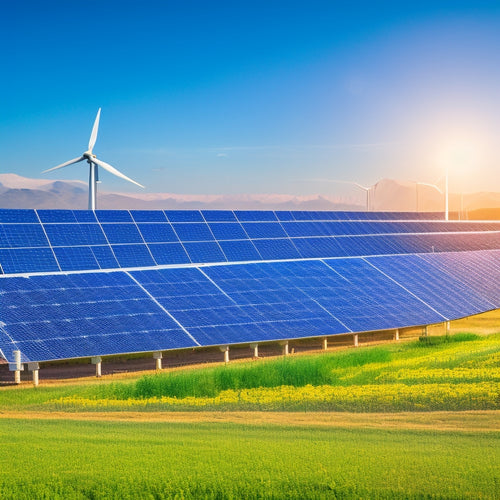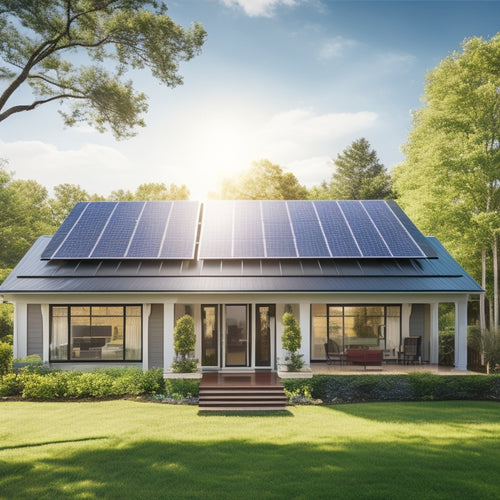
Green Power Technologies in Renewable Energy
Share
Green power technologies are revolutionizing renewable energy by enhancing efficiency and driving down costs. You'll notice that advancements in solar and wind systems, like bifacial solar panels and offshore wind farms, increase energy output considerably. These innovations not only improve energy capture but also reduce environmental impacts through better resource management and recycling initiatives. Energy storage solutions further support the reliability of these systems, ensuring you have power even during peak demand. This change not only cuts costs long-term but also aligns with a sustainable future. Uncovering more about these trends will provide deeper understanding into this essential sector.
At a Glance
- Advancements in solar and wind technologies have significantly reduced costs and improved efficiency, making renewable energy more accessible and cost-effective.
- Innovative solutions like bifacial solar panels and vertical turbines enhance energy capture, optimizing renewable energy generation in various environments.
- Energy storage systems are crucial for managing renewable energy supply, allowing excess energy to be stored and used during peak demand.
- The integration of smart technology in renewable systems improves performance and efficiency, supporting real-time monitoring and grid stability.
- Green power technologies contribute to carbon emission reduction and resource conservation, aligning with sustainability goals and promoting a healthier planet.
Cost-Effective Energy Solutions
As you investigate cost-effective energy solutions, you'll find that advancements in solar energy technology have greatly lowered installation costs and increased efficiency.
The financial benefits and potential savings associated with solar energy investments further enhance its appeal.
Meanwhile, innovations in wind power are enhancing energy capture and storage capabilities, making it a more viable option for diverse geographic locations.
Solar Energy Advancements
While traditional energy sources continue to fluctuate in price and availability, advancements in solar energy technology have emerged as a cost-effective solution for both residential and commercial applications.
One significant development is in solar energy storage systems. These innovations allow you to store excess energy generated during sunny days, ensuring you have a reliable energy source even when the sun isn't shining. This capability not only enhances energy independence but also maximizes the utility of solar panels, reducing reliance on grid power.
Additionally, solar panel recycling is gaining traction, addressing environmental concerns associated with solar technology. As you invest in solar infrastructure, knowing that your panels can be recycled at the end of their lifecycle cultivates a sustainable mindset.
This process not only minimizes waste but also recovers precious materials that can be reused, further driving down costs.
Incorporating these advancements into your energy strategy not only promotes financial savings but also aligns with a commitment to sustainable practices.
The future of solar energy looks promising, offering you the freedom to utilize clean energy while making a positive impact on the environment. Embracing these technologies can enable you to take control of your energy future.
Wind Power Innovations
Wind power innovations are altering the terrain of renewable energy, presenting cost-effective solutions for both individual consumers and large-scale operations. One of the most promising developments is the rise of offshore wind farms. These installations utilize consistent ocean winds to generate substantial electricity, often at lower costs than traditional land-based turbines.
With advancements in turbine technology, you can expect even greater efficiency and energy output.
Vertical turbines are another exciting innovation. They occupy less space and can capture wind from any direction, making them ideal for urban settings. You might find these compact designs particularly appealing if you're considering renewable energy for your home or business. Their lower height and reduced noise levels make them a viable option where conventional turbines might face opposition.
Moreover, as manufacturing processes advance, the cost of producing and installing wind power systems is decreasing. This trend can enable you to invest in clean energy without breaking the bank.
Adopting these technologies not only supports your personal energy independence but also contributes to a sustainable future for all. Welcome these innovations, and you'll be part of a movement toward greater freedom through renewable energy solutions.
Environmental Impact Reduction
By adopting green power technologies, you greatly contribute to carbon emission reduction, which directly impacts climate change mitigation.
These advancements, such as solar power financial benefits, not only help in reducing greenhouse gases but also promote resource conservation, ensuring that essential materials are used more efficiently.
As you investigate these advancements, consider how they can reshape your environmental footprint and enhance sustainability.
Carbon Emission Decrease
Reducing carbon emissions is essential for mitigating climate change and enhancing environmental sustainability. To achieve this, you need to adopt sustainable practices that lower your carbon footprint.
Emission regulations and climate policies play a crucial role in guiding these efforts, pushing for stricter standards that encourage the adoption of green technologies.
Renewable incentives can greatly motivate both individuals and organizations to invest in eco-friendly initiatives. For instance, conducting energy audits allows you to pinpoint inefficiencies and implement targeted solutions, ultimately reducing emissions.
Additionally, carbon trading systems offer a market-based approach to encourage emission reductions, enabling you to buy or sell carbon credits based on your performance.
Resource Conservation Benefits
Resource conservation plays an essential role in minimizing environmental impacts and promoting sustainability. By implementing effective resource management strategies, you can greatly reduce waste and optimize the use of natural resources. This isn't just about preserving the environment; it's about ensuring that future generations have access to the same resources we enjoy today.
Adopting sustainable practices lets you make conscious choices that benefit both the planet and your community. For instance, utilizing renewable energy sources like solar and wind reduces your reliance on fossil fuels, which contributes to lower greenhouse gas emissions.
In addition, by recycling and reusing materials, you decrease the demand for raw materials, lessening the strain on ecosystems.
You also enable yourself to drive change within your organization or community. When you prioritize resource efficiency, you not only cut costs but also cultivate a culture of sustainability. This proactive approach encourages innovation, inspiring others to follow suit.
Ultimately, embracing resource conservation isn't just a personal choice; it's a collective movement toward a healthier planet. By integrating these practices into your daily life, you're not just conserving resources; you're setting the stage for a sustainable future.
Innovative Energy Generation Methods
As you investigate innovative energy generation methods, you'll notice significant advancements in solar panel technology, such as increased efficiency and integrated storage solutions.
These advancements are further complemented by the emergence of solar battery systems, which allow for effective storage of excess energy, ensuring that households can harness renewable energy even during non-sunny hours.
Wind turbine innovations are also reshaping the environment, with designs that maximize energy capture even in low-wind conditions.
Together, these developments aren't just enhancing energy output but also driving down costs, making renewable sources more accessible than ever.
Solar Panel Advancements
Recent advancements in solar panel technology are transforming energy generation methods and enhancing efficiency like never before. You'll find that innovations in photovoltaic technology have led to significant improvements in solar panel efficiency, making it more accessible and viable for everyday use.
New materials, such as perovskites, are emerging as revolutionary, allowing panels to capture a wider range of sunlight while reducing production costs.
Furthermore, the integration of bifacial solar panels is increasing energy yield by capturing sunlight from both sides. This approach is especially beneficial in urban environments, where rooftops can take advantage of reflected light from surrounding surfaces.
Additionally, advancements in tracking systems enable panels to follow the sun's path, maximizing energy capture throughout the day.
As you investigate these developments, consider the implications for your energy independence. With improved solar panel efficiency, generating your own power becomes not just a dream but a practical reality.
By adopting these state-of-the-art technologies, you enable yourself to contribute to a sustainable energy future while enjoying the freedom that comes with renewable energy solutions.
Welcome the possibilities that modern solar technology offers for a brighter, greener tomorrow.
Wind Turbine Innovations
While solar energy continues to make strides, wind turbine innovations are equally reshaping the terrain of renewable energy generation. You'll find that advancements in turbine design and blade materials are critical to enhancing efficiency and output. New aerodynamic shapes are being engineered to capture wind from various angles, allowing turbines to perform at peak performance even in lower wind conditions.
Innovative blade materials, such as carbon fiber and advanced composites, not only reduce weight but also increase durability, enabling turbines to withstand harsher weather conditions. These materials enhance the overall lifespan of turbines, translating into lower maintenance costs and increased energy production.
Moreover, the integration of smart technology in turbine systems is revolutionizing how you utilize wind energy. Sensors and AI algorithms are optimizing performance in real-time, ensuring that each turbine operates at peak efficiency.
As you investigate the future of renewable energy, these innovations in wind turbine technology promise to provide greater energy independence and sustainability. By investing in these developments, you're not just supporting a cleaner planet; you're embracing a future where energy freedom is within reach.
Assessing Energy Efficiency Ratings
When evaluating energy efficiency ratings, you need to understand the various metrics used to gauge performance.
Different systems can yield varying results, making comparisons critical for informed decision-making. Factors such as system size and battery type influence these ratings, highlighting the importance of selecting the right configuration for your energy needs.
Understanding Energy Efficiency Metrics
Understanding energy efficiency metrics is vital for making informed decisions about energy consumption and sustainability. By grasping these metrics, you can assess how well a device or system converts energy into useful output while minimizing waste.
Efficiency benchmarks serve as important reference points, allowing you to compare the performance of various technologies.
When evaluating a product's energy efficiency, look for ratings such as Energy Star or the Seasonal Energy Efficiency Ratio (SEER). These ratings not only indicate how energy consumption stacks up against industry standards but also reveal potential cost savings over time.
Understanding these metrics enables you to choose solutions that align with your values of sustainability and freedom.
It's also important to recognize that energy efficiency isn't just about the immediate savings. Consider how improvements in efficiency can contribute to a larger goal of reducing overall energy demand, ultimately leading to a more sustainable future.
Comparing Efficiency Rating Systems
Maneuvering through the terrain of energy efficiency ratings can feel overwhelming, but breaking down the various systems helps clarify their significance. You'll encounter several efficiency benchmarks that serve as performance metrics, guiding your decisions towards sustainable technologies.
Systems like ENERGY STAR, LEED, and HERS offer distinct criteria, reflecting different priorities in energy use and environmental impact.
When comparing these rating systems, consider their methodologies. For instance, ENERGY STAR focuses primarily on building performance, emphasizing reduced energy consumption without compromising comfort.
In contrast, LEED evaluates a broader range of sustainability factors, including site development, water efficiency, and indoor environmental quality. HERS, on the other hand, provides a specific score based on a home's energy efficiency, making it an essential tool for homeowners and builders.
Understanding these subtleties equips you to make informed choices that align with your values and goals. By evaluating the efficiency benchmarks and performance metrics each system offers, you can strategically prioritize which technologies and practices best support your vision for a sustainable future.
This clarity not only enhances your decision-making but also contributes to the broader movement towards renewable energy adoption.
Higher Long-Term Savings
When you consider green power technologies, their cost-effective energy solutions become evident over time.
By investing in sustainable systems, you're not just reducing your carbon footprint; you're also releasing significant long-term savings on your energy bills.
Analyzing these savings can reveal a clear financial advantage, converting initial expenditures into a more profitable future.
Cost-Effective Energy Solutions
In today's energy environment, utilizing cost-effective solutions is vital for maximizing long-term savings. One of the most effective strategies you can employ involves energy storage systems. These technologies allow you to store excess energy generated during peak production times, enabling you to use it when demand surges or when generation dips. This not only reduces reliance on expensive grid power but also stabilizes your energy costs over time.
Moreover, grid integration plays an essential role in achieving these savings. By seamlessly connecting renewable energy sources to the existing electricity grid, you enhance efficiency and reliability. This integration allows for optimized usage of distributed energy resources, reducing the strain on conventional power sources.
Incorporating smart technologies further amplifies savings; they enable real-time monitoring and management of energy consumption. As you capitalize on these cost-effective solutions, you gain greater control over your energy expenses while contributing to a more sustainable energy future.
Investing in these technologies not only aligns with your desire for independence but also guarantees that your energy strategy remains resilient against fluctuating market conditions. Embracing these advancements is your pathway to financial freedom and environmental responsibility.
Frequently Asked Questions
What Types of Renewable Energy Technologies Are Available Today?
Today, you've got various renewable energy technologies at your disposal: solar panels utilize sunlight, wind turbines capture air currents, geothermal systems tap underground heat, while biomass energy, hydroelectric power, tidal energy, and ocean thermal expand your options.
How Do Green Power Technologies Outperform Traditional Energy Sources?
You'll find green power technologies outperform traditional sources by providing efficiency benefits, reducing environmental impact, offering significant cost savings, and promoting energy independence. These factors enable you to make sustainable choices for a cleaner future.
What Are the Government Incentives for Adopting Renewable Energy Solutions?
Imagine installing solar panels and receiving substantial tax credits. Governments offer incentives like feed-in tariffs, renewable grants, and energy efficiency rebates, making it financially appealing for you to adopt renewable energy solutions and enhance your freedom.
How Can I Transition My Home to Use Renewable Energy?
To shift your home to renewable energy, investigate solar panel installation for efficient energy generation and consider wind turbine options for additional power. Both methods enhance your independence while contributing to a sustainable future.
What Are the Common Misconceptions About Green Power Technologies?
You might think technology barriers limit green power's effectiveness. However, myths debunked reveal that many innovations are accessible and affordable. Embracing renewable energy can enable you to live sustainably without sacrificing comfort or convenience.
Explore More
Incorporating green power technologies is like planting seeds for a sustainable future. By embracing cost-effective energy solutions and innovative generation methods, you're not just reducing environmental impact; you're also enhancing energy efficiency and securing long-term savings. As you steer through this changing environment, remember that each decision you make contributes to a cleaner, more resilient energy ecosystem. Utilizing renewable energy isn't merely an option; it's a crucial step toward a brighter, more sustainable tomorrow.
Related Posts
-

Top Portable Refrigerators for Camping Adventures
When you're camping, having a reliable portable refrigerator can make all the difference for keeping your food fresh ...
-

The Role of Battery Monitoring Systems in Renewable Energy
Battery monitoring systems play an essential role in renewable energy by enhancing system longevity and optimizing pe...
-

Home Solar Installation Cost
You're considering installing solar panels on your home, and the upfront cost is likely the biggest hurdle standing i...


